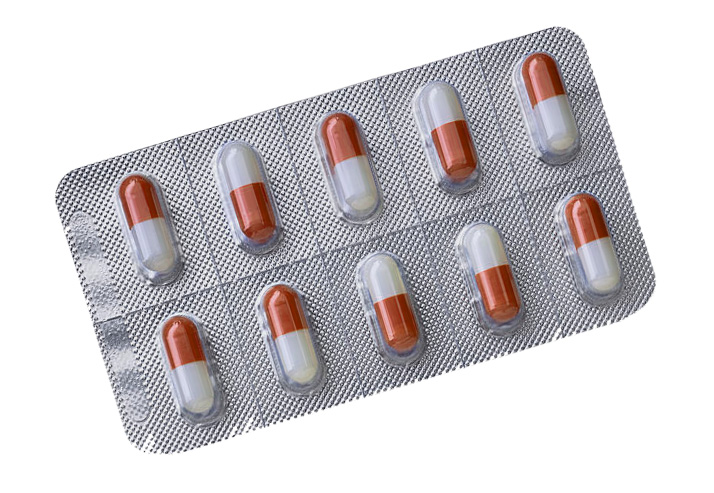Duricef
Duricef is an antibiotic belonging to the beta-lactam family. The active substance is cefadroxil, which belongs to the group of antibiotics known as first-generation cephalosporins.
This medicine is indicated for the treatment of certain susceptible bacterial infections.
What Does Duricef Contain?

The active substance is:
- Cefadroxil monohydrate 525.00 mg
- Quantity corresponding to cefadroxil 500.00 mg
- For a 0.660 g capsule.
The other ingredients are:
- Sodium lauryl sulphate, magnesium stearate, microcrystalline cellulose
- The capsule shell consists of gelatin and titanium dioxide.
Forms and Strengths
Blister (PVC-PVDC/Aluminium).
Bottle (Polypropylene).
Box of 10, 12, 16 or 20 capsules.
Uses
These are based on the antibacterial activity and pharmacokinetic characteristics of Duricef. They take into account both the clinical studies to which the medicinal product has been subjected and its place in the range of antibacterial products currently available.
They are limited to infections caused by susceptible germs, where these infections can be treated with oral antibiotics, and exclude meningeal infections, in particular:
- ENT infections: tonsillitis, sinusitis, otitis.
Lower respiratory infections:
- superinfections of acute bronchitis,
- exacerbations of chronic bronchitis.
O community-acquired pneumonia in subjects:
- with no risk factors
- without signs of clinical severity
- with no evidence of penicillin resistance in S.pneumoniae,
- in the absence of evidence suggestive of atypical pneumopathy.
Uncomplicated urinary tract infections, with the exception of prostatitis and pyelonephritis.
How To Take
Always take this medicine exactly as prescribed by your doctor or pharmacist. Check with your doctor or pharmacist if in doubt.
This medicine is intended for adults and children aged 6 and over.
Dosage
The usual dose is as follows:
Adults: 2 g per day (4 capsules) in at least two doses.
In children aged 6 and over: 50 mg/kg/day in at least two doses without exceeding the adult dose (2 g/day).
Dosage should be adjusted in cases of renal impairment.
In patients with impaired renal function:
In the case of renal insufficiency, the dosage is adapted according to creatinine clearance or creatininemia:
- > 40 ml/min: 1 g every 12 hours;
- 20 to 40 ml/min: 500 mg every 12 hours;
- < 20 ml/min: 500 mg every 24 hours.
Duration of treatment
The average duration of treatment is 7 to 10 days for all therapeutic indications, and up to 14 days for pneumonia. A minimum of ten days' treatment is recommended for all beta-haemolytic streptococcal infections.
Method of administration
The capsules should be swallowed with a glass of water, before or during meals.
If you have taken more Duricef than you should have
Consult your doctor or pharmacist immediately.
If you forget to take Duricef
Do not take a double dose to make up for the one you have forgotten to take.
If you stop taking Duricef
For this antibiotic to be effective, it is crucial to take it consistently at the doses prescribed by your doctor and for the full duration recommended. It's important to complete the entire course of treatment, even if you start feeling better beforehand. Stopping the treatment prematurely can lead to a resurgence of the infection or a worsening of your condition. Additionally, discontinuing early may promote the development of antibiotic-resistant bacteria.
The disappearance of fever or any other symptoms does not mean that you are completely cured.
Any sensation of fatigue is attributed to the infection, not the antibiotic treatment. Reducing or stopping your treatment will not alleviate this sensation and may hinder your recovery.
If you have any further questions about the use of this medicine, please ask your doctor, pharmacist or nurse.
Side Effects
Like all medicines, this product may cause undesirable effects, but these do not always occur in everyone.
Allergic reactions: skin rash, angioedema (sudden swelling of the face and neck of allergic origin), urticaria, itching.
Very rarely: allergic shock, Stevens-Johnson syndrome (skin detachment that can rapidly and severely spread throughout the body), erythema multiforme (skin disease).
Rare cases of reactions resembling serum sickness (a disease caused by an allergic reaction) have been reported. This is a skin rash, usually urticarial, with joint pain, with or without fever, usually occurring during or after a second or nth administration of the drug. These symptoms, which have been described more frequently in young children, subside without sequelae a few days after treatment is stopped.
Changes in the blood count: increase or decrease in certain white blood cells (eosinophilia, neutropenia, agranulocytosis).
Digestive issues such as nausea, vomiting, and diarrhea are common. In very rare instances, severe, persistent, or bloody diarrhea accompanied by abdominal pain or fever may occur, signaling serious intestinal inflammation. This is an uncommon but possible complication following antibiotic treatment.
Impaired kidney function, especially in association with aminoglycosides (another class of antibiotics) or diuretics.
Increase in certain liver enzymes (ASAT, ALAT).
Vaginal manifestations: inflammation of the vagina (vaginitis).
Precautions
Never take Duricef:
- if you are allergic to cefadroxil or other cephalosporin antibiotics or to any of the other ingredients of this medicine.
Talk to your doctor, pharmacist or nurse before taking Duricef in case of:
- renal insufficiency,
- a history of allergy, particularly to antibiotics.
Any allergic reaction (skin rash, itching, etc.) during treatment should be reported immediately to your doctor.
Before taking this treatment, tell your doctor if you have had an allergic reaction to a previous antibiotic treatment: hives or other skin rashes, itching, angioedema (sudden swelling of the face and neck due to allergy). If you are in any doubt about your history, take the medicine in the presence of your doctor.
In the event of severe, persistent or bloody diarrhoea, during or following treatment with Duricef, consult your doctor immediately as it may be necessary to discontinue treatment. This may be a sign of intestinal inflammation (pseudomembranous colitis) which may occur following antibiotic treatment.
Administration of this medicine with a meal reduces nausea without affecting absorption.
This medicine may cause a false positive reaction in certain laboratory tests, particularly urine glucose tests.
Children and adolescents
Tablets and capsules should not be taken by children under 6 years of age, as they may swallow them incorrectly and choke. Other pharmaceutical forms of cefadroxil, such as granules for oral suspension, are more suitable for young children.
Other medicinal products and Duricef
Tell your doctor or pharmacist if you are taking, have recently taken or may take any other medicines.
The administration of Duricef may disturb the therapeutic balance of an anticoagulant treatment.
If you are taking probenecid (gout treatment), the elimination of Duricef by your body may be delayed.
Changes in INR
There have been many reports of heightened activity of oral anticoagulants in patients who are taking antibiotics. The infectious and inflammatory context, age and general condition of the patient appear to be risk factors. In these circumstances, it is difficult to determine the extent to which the infection and its treatment are responsible for the imbalance in INR. However, certain families of antibiotics are more involved, notably fluoroquinolones, macrolides, cyclins, cotrimoxazole and certain cephalosporins.
Probenecid
Concomitant administration of probenecid reduces the renal elimination of cefadroxil. Consequently, plasma concentrations of cefadroxil may be increased when cefadroxil is co-administered with probenecid.
Duricef with food and drink
Not applicable.
Driving vehicles and using machines
Not applicable.
Duricef contains sodium.
Pharmacokinetic Properties
Absorption
Cefadroxil is well absorbed (80-90%) by the digestive tract.
This absorption is not affected by food intake.
For an oral dose of 500 mg and 1000 mg, peak plasma concentrations are 13 to 18 mg/l and 26 to 35 mg/l respectively. Tmax is 60 to 90 minutes.
Serum concentrations remain effective for 4 to 6 hours following a 1 g dose.
The pharmacokinetics of cefadroxil administered orally are linear for doses between 250 mg and 1000 mg.
Distribution
Plasma protein binding is 15-20%.
Tissue distribution: good tissue penetration observed in the lungs (pleural fluid, lung parenchyma), ENT (tonsils), bone, prostate, as well as bile and synovial fluid, with tissue peaks corresponding to 10 to 35% of the plasma Cmax value.
Elimination
The half-life is 1.6 to 2 hours.
Elimination occurs mainly in the urine in the active form via glomerular filtration and tubular secretion (probenecid increases the elimination half-life by 50%). High urinary concentrations are obtained, of the order of 1000 µg/ml in urine over 6 hours for a single 500 mg dose and of the order of 1000 to 3000 µg/ml for a single 1 g dose.
80-90% of the dose administered is found in the urine over 24 hours.
Pregnancy and Breastfeeding
This medication can be used during pregnancy when necessary.
Animal studies have shown no teratogenic effects. Generally, substances that cause malformations in humans are also found to be teratogenic in animal studies involving two different species.
Clinically, the examination of a large number of pregnancies exposed to Duricef has not shown any specific malformative or fetotoxic effects. However, only epidemiological studies can confirm the absence of risk.
Therefore, cefadroxil can be prescribed during pregnancy if deemed necessary by your healthcare provider.
Breastfeeding is feasible while taking this medication. Cefadroxil is transferred into breast milk in low amounts, significantly lower than therapeutic doses, making it generally safe during breastfeeding.
However, if your newborn exhibits symptoms such as diarrhea, skin rashes, or candidiasis (an infection caused by certain types of yeast), you should inform your doctor right away for appropriate guidance, as these could be reactions to the medication.



